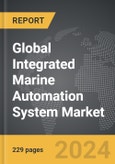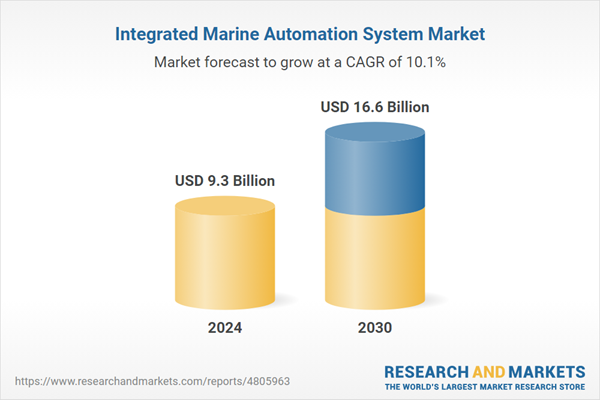Global Integrated Marine Automation System Market - Key Trends & Drivers Summarized
What Are Integrated Marine Automation Systems and Why Are They Essential for Modern Vessels?
Integrated marine automation systems (IMAS) are advanced technological solutions that centralize the control and monitoring of various shipboard systems, including navigation, engine management, power distribution, and safety systems. These systems are essential for modern vessels, where the complexity of operations and the need for efficiency and safety are paramount. By integrating multiple subsystems into a single platform, IMAS enable seamless communication and coordination between different onboard systems, reducing the workload for crew members and minimizing the risk of human error. This integration not only improves operational efficiency but also enhances the safety and reliability of marine operations. As the maritime industry continues to evolve, with increasing emphasis on automation and digitalization, the role of integrated marine automation systems in supporting these advancements is becoming increasingly critical.How Are Technological Innovations Shaping the Integrated Marine Automation System Market?
Technological innovations are significantly influencing the integrated marine automation system market, particularly through the adoption of advanced sensors, data analytics, and artificial intelligence (AI). The integration of AI into IMAS is enabling the development of more intelligent and autonomous vessels, capable of making real-time decisions and optimizing operations without human intervention. Advanced sensor technologies are improving the accuracy and reliability of data collected from various shipboard systems, allowing for more precise monitoring and control. The use of big data analytics is also enhancing the capabilities of IMAS, enabling ship operators to analyze vast amounts of data and gain insights that can improve operational efficiency and reduce fuel consumption. Additionally, the rise of digital twins - virtual replicas of physical vessels - is allowing for the simulation and optimization of ship performance, further enhancing the functionality of integrated marine automation systems. These technological advancements are driving the development of more sophisticated and capable IMAS, which are increasingly being adopted across the maritime industry.Why Is There an Increasing Demand for Integrated Marine Automation Systems in the Maritime Industry?
The demand for integrated marine automation systems is growing rapidly in the maritime industry due to the increasing complexity of modern vessels and the need to comply with stringent safety and environmental regulations. As ships become larger and more technologically advanced, the need for integrated systems that can provide seamless control over multiple functions is becoming more critical. The push towards autonomous and semi-autonomous vessels is also driving demand for IMAS, as these systems are essential for enabling the level of automation and remote operation required for these next-generation ships. Additionally, the growing focus on fuel efficiency and emissions reduction is leading shipping companies to adopt IMAS that can optimize route planning and engine performance, helping them to meet regulatory requirements and reduce operating costs. The increased emphasis on crew safety and training is another factor contributing to the demand for IMAS, as these systems provide enhanced situational awareness and decision support, reducing the likelihood of accidents and improving overall operational safety.What Factors Are Driving the Growth in the Integrated Marine Automation System Market?
The growth in the integrated marine automation system market is driven by several factors that are shaping the future of maritime operations. One of the primary drivers is the increasing adoption of automation technologies, which require integrated systems to function effectively. The global push towards maritime safety and environmental sustainability is also a key factor, as shipping companies seek to comply with international regulations and reduce their environmental impact through more efficient and safer operations. The rising demand for autonomous and remotely operated vessels is further driving the adoption of IMAS, as these systems are essential for enabling the complex control and monitoring capabilities required for such vessels. Additionally, the growing emphasis on operational efficiency and cost reduction in the shipping industry is leading companies to invest in IMAS that can optimize fuel consumption, reduce maintenance costs, and improve overall fleet management. These factors, combined with ongoing technological advancements and the increasing digitalization of maritime operations, are expected to drive continued growth in the integrated marine automation system market.Report Scope
The report analyzes the Integrated Marine Automation System market, presented in terms of market value (USD). The analysis covers the key segments and geographic regions outlined below.- Segments: Autonomy (Remotely-Operated, Partial Automation, Fully Autonomous); Ship Type (Defense, Commercial, Unmanned); System (Vessel Management Systems, Power Management Systems, Process Control Systems, Safety Systems).
- Geographic Regions/Countries: World; United States; Canada; Japan; China; Europe (France; Germany; Italy; United Kingdom; and Rest of Europe); Asia-Pacific; Rest of World.
Key Insights:
- Market Growth: Understand the significant growth trajectory of the Remotely-Operated System segment, which is expected to reach US$8.4 Billion by 2030 with a CAGR of 10.2%. The Partial Automation System segment is also set to grow at 9.4% CAGR over the analysis period.
- Regional Analysis: Gain insights into the U.S. market, valued at $2.7 Billion in 2024, and China, forecasted to grow at an impressive 8.4% CAGR to reach $2.3 Billion by 2030. Discover growth trends in other key regions, including Japan, Canada, Germany, and the Asia-Pacific.
Why You Should Buy This Report:
- Detailed Market Analysis: Access a thorough analysis of the Global Integrated Marine Automation System Market, covering all major geographic regions and market segments.
- Competitive Insights: Get an overview of the competitive landscape, including the market presence of major players across different geographies.
- Future Trends and Drivers: Understand the key trends and drivers shaping the future of the Global Integrated Marine Automation System Market.
- Actionable Insights: Benefit from actionable insights that can help you identify new revenue opportunities and make strategic business decisions.
Key Questions Answered:
- How is the Global Integrated Marine Automation System Market expected to evolve by 2030?
- What are the main drivers and restraints affecting the market?
- Which market segments will grow the most over the forecast period?
- How will market shares for different regions and segments change by 2030?
- Who are the leading players in the market, and what are their prospects?
Report Features:
- Comprehensive Market Data: Independent analysis of annual sales and market forecasts in US$ Million from 2024 to 2030.
- In-Depth Regional Analysis: Detailed insights into key markets, including the U.S., China, Japan, Canada, Europe, Asia-Pacific, Latin America, Middle East, and Africa.
- Company Profiles: Coverage of players such as ABB Group, Api Marine Inc., Consilium AB, Honeywell International, Inc., Kongsberg Gruppen ASA and more.
- Complimentary Updates: Receive free report updates for one year to keep you informed of the latest market developments.
Some of the 12 companies featured in this Integrated Marine Automation System market report include:
- ABB Group
- Api Marine Inc.
- Consilium AB
- Honeywell International, Inc.
- Kongsberg Gruppen ASA
- Marine Technologies, LLC.
- Mtu Friedrichshafen GmbH
- Northrop Grumman Corporation
- Praxis Automation Technology B.V.
- Siemens AG
- Thales Group
- Tokyo Keiki, Inc.
- Wartsila Corporation
This edition integrates the latest global trade and economic shifts into comprehensive market analysis. Key updates include:
- Tariff and Trade Impact: Insights into global tariff negotiations across 180+ countries, with analysis of supply chain turbulence, sourcing disruptions, and geographic realignment. Special focus on 2025 as a pivotal year for trade tensions, including updated perspectives on the Trump-era tariffs.
- Adjusted Forecasts and Analytics: Revised global and regional market forecasts through 2030, incorporating tariff effects, economic uncertainty, and structural changes in globalization. Includes historical analysis from 2015 to 2023.
- Strategic Market Dynamics: Evaluation of revised market prospects, regional outlooks, and key economic indicators such as population and urbanization trends.
- Innovation & Technology Trends: Latest developments in product and process innovation, emerging technologies, and key industry drivers shaping the competitive landscape.
- Competitive Intelligence: Updated global market share estimates for 2025, competitive positioning of major players (Strong/Active/Niche/Trivial), and refined focus on leading global brands and core players.
- Expert Insight & Commentary: Strategic analysis from economists, trade experts, and domain specialists to contextualize market shifts and identify emerging opportunities.
Table of Contents
Companies Mentioned (Partial List)
A selection of companies mentioned in this report includes, but is not limited to:
- ABB Group
- Api Marine Inc.
- Consilium AB
- Honeywell International, Inc.
- Kongsberg Gruppen ASA
- Marine Technologies, LLC.
- Mtu Friedrichshafen GmbH
- Northrop Grumman Corporation
- Praxis Automation Technology B.V.
- Siemens AG
- Thales Group
- Tokyo Keiki, Inc.
- Wartsila Corporation
Table Information
| Report Attribute | Details |
|---|---|
| No. of Pages | 229 |
| Published | December 2025 |
| Forecast Period | 2024 - 2030 |
| Estimated Market Value ( USD | $ 9.3 Billion |
| Forecasted Market Value ( USD | $ 16.6 Billion |
| Compound Annual Growth Rate | 10.1% |
| Regions Covered | Global |









